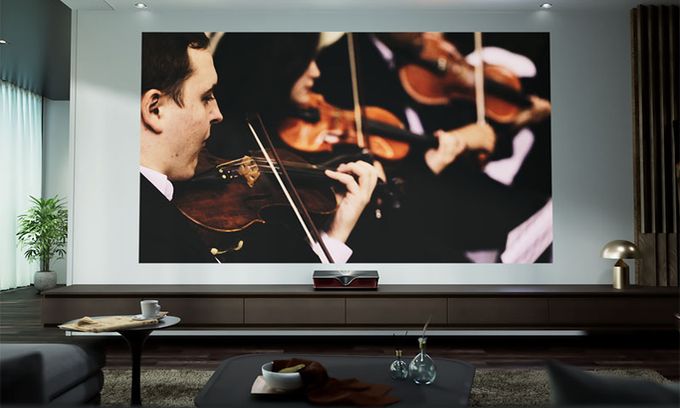The young American Nomvdic Corporation, Diamond Bar, CA, United States, specializes in projectors. In a short time, the company has already created several quite competitive DLP models, including bright P1000 4K short throw, portable L500 with triple laser light engine, outdoor X300, etc.
It’s no secret that many companies compensate for the lack of brand reputation through price. As a result, their models offer good value for money, making them more competitive. Judging by the specs and prices, Nomvdic also follows this trend. For example, the 4K gaming P1000 short throw projector (4.2ms input lag, 2,300 ANSI Lumens brightness, up to 180″ big screen) costs ~$ 1,600, which is not much for its specs. Moreover, all Nomvdic models offer superb audio with Harman / Kardon speakers.
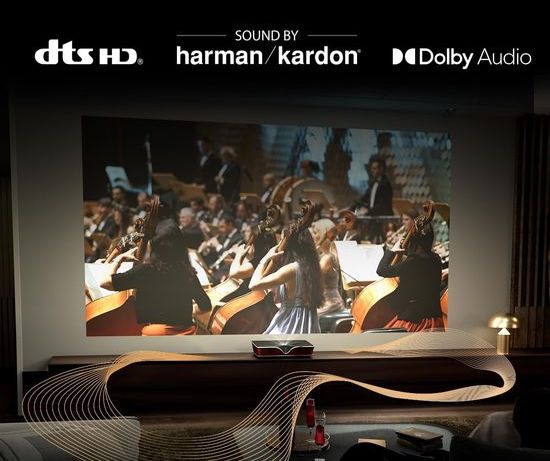
Finally, a fairly large number of positive customer reviews also indirectly confirms their high reliability.
Laser projectors
Nomvdic P2000 RGB Laser TV with premium specs became the first Nomvdic Ultra Short Throw (UST) 4K projector.
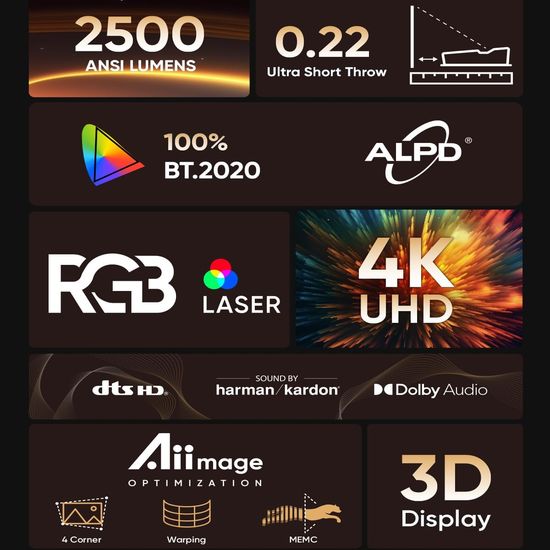
As known, their popularity has been growing rapidly in recent years, which is due to completely objective reasons. The idea of using projectors as an alternative to TV in the living room is obvious. But traditional mid-focal models with lamp or LED light sources have several significant cons.
Their throw distance is several meters and requires placement in the center of the room, which creates the problem of wires on the floor. This is especially inconvenient in families with children or pets. In fact, complex and troublesome ceiling mount is the only solution today. The UST generates a large projection from a very short distance and is installed close to the screen. For example, throw distance of Nomvdic P2000 varies in the range 6.7″-16.1″ (0.3 m – 0.7 m).
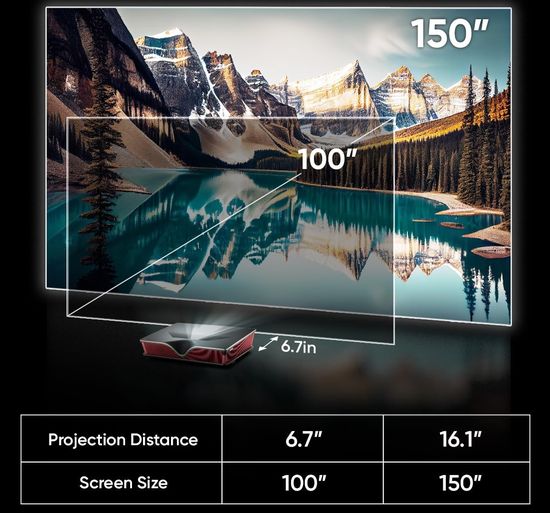
Reliable and bright lamp models are noisy and bulky due to the powerful fans to cool the lamp and the need for efficient heat dissipation.
The projectors with SSL (solid state light source) light engines practically do not heat up, and their service life reaches 30,000 hours. They use ordinary or laser LEDs. Laser version provides more powerful coherent radiation due to an optical cavity.
The power of LED projectors is too low and they are usually used in low-power portable models. To be fair, companies quite successfully solve this problem, using, for example, a 4LED circuit with additional blue LED.
Laser projectors are powerful enough to compensate for ambient light, which makes colors appear dull and faded. In principle, brightness of more than 2,000 ANSI Lumens is already sufficient for acceptable image quality even in diffuse daylight.
UST projectors vs TVs
Modern models use ALPD (Advanced Laser Phosphor Display) technology, including ALPD 3.0 (laser+phosphor) or ALPD 4.0 (triple laser RGB light generator). ALPD 3.0 – based models are cheaper. More expensive RGB light generators provide ultra-wide color gamut with coverage up to 100% BT.2020 color space, but their image may contain speckles due to interference.
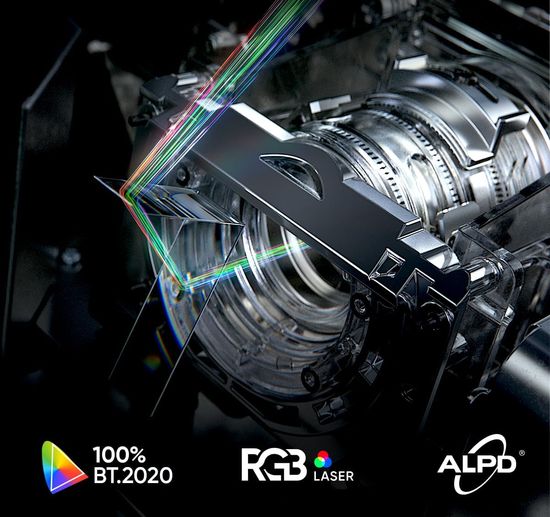
In fairness, last year’s Dangbei X5 Ultra already uses 5 gen of this technology. Its hybrid light engine has three lasers and three LEDs, delivering 2,500 CVIA Lumens (~4,200 ANSI Lumens), 120% (Rec.2020) / 165% (DCI-P3) / 210% (Rec.709) color gamut and unprecedented DeltaE < 1 color accuracy 'out of the box'. However, XGIMI Horizon Ultra also uses hybrid laser-LED light engine. Probably, this direction is one of the most promising for further development of ALPD technology.
In addition, pixel shift-based XPR (Xpanded Pixel Resolution) technology in DLP DMD (Digital Micromirror Device) chipsets from Texas Instrument has successfully solved the high cost problem for 4K DLP projectors. Its operation principle is simple, but very elegant.
A projector with a relatively cheap DLP 1080p chipset (2 million micromirrors) divides 8 million pixels of 4K content into four parts of 2 million pixels each. It then sequentially plays 4 separate 1080p frames diagonally shifted by half a pixel from each other.
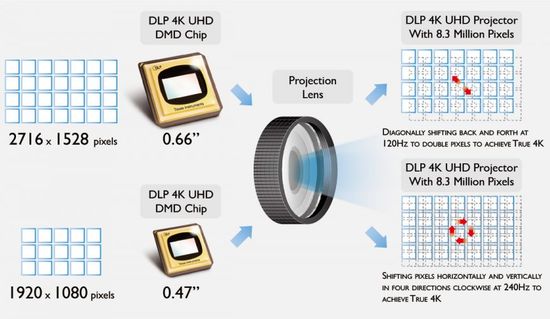
Our vision perceives them as one clearer picture, ignoring the micro-delay due to high frequency. For pixel shift, the projector uses the lens tilt with 4 electromagnets of the XPR module.
Finally, streaming and screen mirroring technologies have solved the problem of content delivery.
As a result, today more and more consumers are choosing UST projectors as an alternative to TV in the living room.
Nomvdic P2000
Of course, the industrial, extravagant design is one of the key features of the Nomvdic P2000 Laser TV.
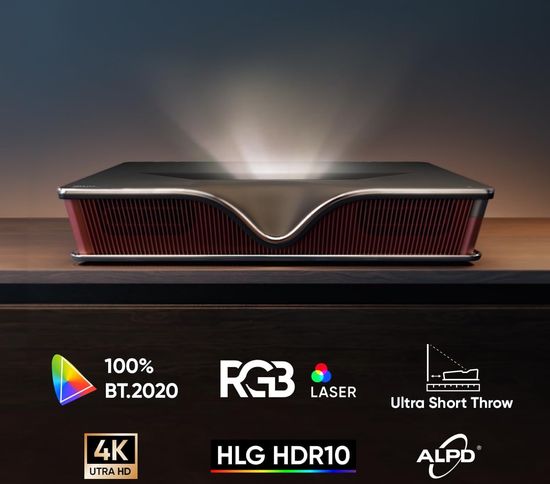
Model uses Texas Instrument’s 0.47-inch DLP 1080p XPR chip with 4-phase pixel shifting. Traditionally for this chipset, the projector reproduces sharp UHD (3,840 x 2,160) images.
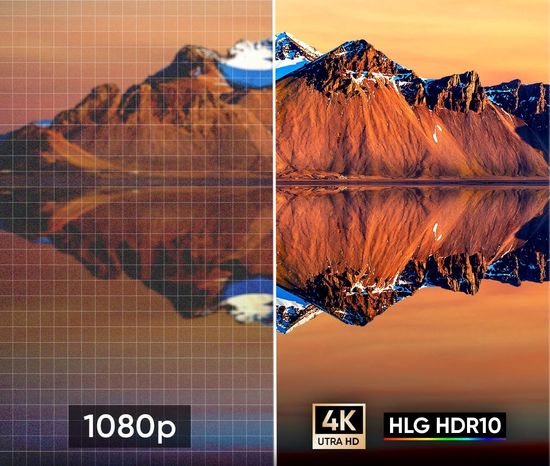
With the exception of saturated reds, the P2000 produces images with virtually no laser speckle. The test results even slightly exceed the brightness specified in the specs.
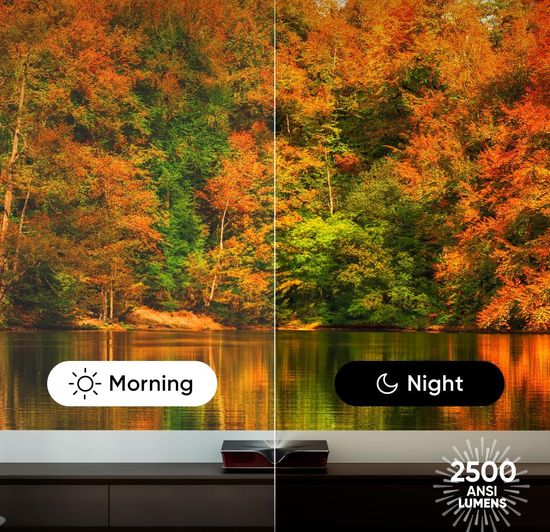
For example, the measured Normal brightness ranges from 2,330 to nearly 3,000 ANSI Lumens in SDR, and exceeds 2,600 ANSI Lumens in HDR.
A native contrast rating is 3,300:1 / 5,400:1 (FOFO), dynamic contrast ratio reaches 3,000,000:1.
Image Size varies from 100″ to 150″ with Throw Distance 6.7″-16.1″ (0.3 m – 0.7 m) at 0.22:1 Throw Ratio. Given the 17″ model depth, the distance between its front edge and the screen wall reaches 24″. Moreover, the model also has a ceiling mount, which seems redundant for a UST projector.
Instead of a built-in smart platform, the P2000 offers 3x HDMI 2.1 ports with 32Gbps bandwidth support. This solution may seem controversial, but many people prefer to use a third-party media streamer. Particularly to receive content from streaming services, the P2000 comes with a Fire TV 4K Max dongle.
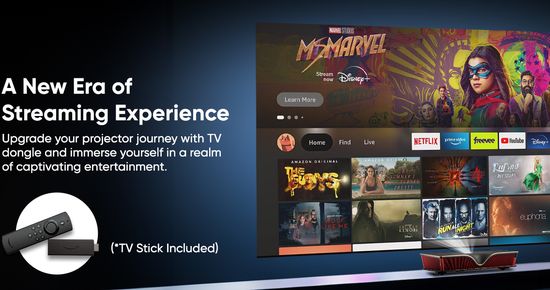
Unfortunately, the functionality of the ports has has several limitations, including support for the popular ALLM (Auto Low Latency Mode) and 4K@120Hz.
AiiO technology with 4-corner keystone and warp adjustment makes the projector easy to install.
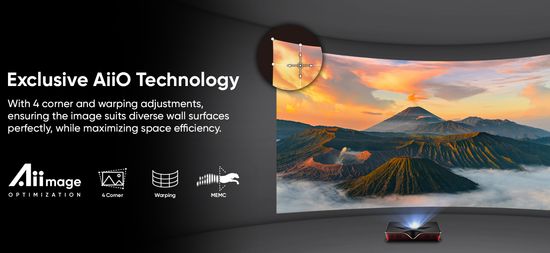
But they are automatically blocked when certain features are activated, including, for example, 3X Fast Input.
Color Modes
The P2000 offers eight picture modes, including six for SDR (Brightest, TV, Movie, Gaming, Low Blue Light and User) and two for HDR (TV-HDR and Movie-HDR). Unfortunately, the Brightest and TV modes are biased toward green and blue, respectively. The other modes use a color temp from 7,500K to 9,500K range with blue-tinged tints. Movie mode with a 6,500K is the most accurate, but also has a slight bluer bias.
Additionally, the P2000 controls offer a color temp adjustment, Contrast, Brightness, Saturation, Tint, and Gamma. Preset Gamma settings are 2.2, 2.3, 2.35, etc.
Overall, the preset picture modes provide acceptable color accuracy. However, lower Saturation and warmer Color Temp (6,500K) slightly improve image quality. So a little calibration may be useful.
In particular, testing measurements demonstrated a decrease in DeltaE for Rec.709 in SDR up to 2.7dE average. Unfortunately, the Color Management System (CMS) in HDR is ineffective because the image is too decolorized.
But the optimal compromise between colors oversaturation and color accuracy depends on personal preferences and content. Moreover, physics uses red, green and blue, but red, yellow and blue are the primary colors in painting.
Smooth playback is ensured using MEMC (Motion Estimation Motion Compensation – frame interpolation).
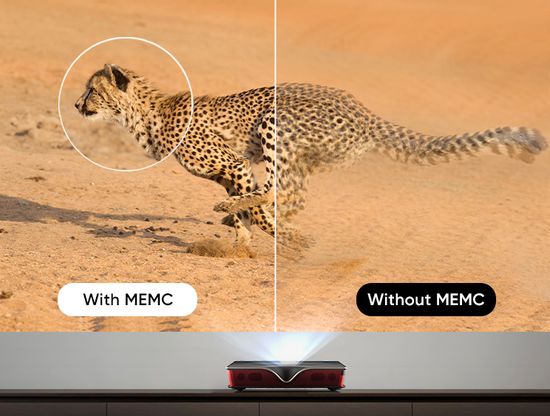
3X Fast Input in the Gaming mode reduces input lag to a ~18 ms for 1080p/2160p@60Hz. But this function is not available for 30Hz / 120Hz signals. However, most current games offer a 60Hz mode.
Two built-in Harman Kardon’s 25W speakers will allow most users to save on an external soundbar. Except for the lower basses, it’s superb. However, for music lovers, the model offers eARC (Enhanced Audio Return Channel) to add an external audio system. As known, it provides a full-resolution audio signal transmission via an HDMI cable without distortion.
Conclusion
Pros
– wide color gamut (100% BT.2020) and 2,500 ANSI Lumens brightness with ALPD 4.0-based triple laser RGB light engine;
– HDR10 support;
– low input lag (18 ms for 1080p/2160p@60Hz with 3X Fast Input);
– built-in 2x 25W Harman / Kardon speakers;
– eARC support;
– 3D support;
– industrial design;
– almost no laser speckle.
Cons
– no built-in smart platform;
– accurate color picture in SDR requires calibration;
– 3X Fast Input only for 60Hz;
– some picture controls are not available in HDR picture modes.
The projector has excellent marketing prospects due to its superb price-quality ratio. Indeed, at a price of ~$ 2,800, the model offers brightness up to 3,000 ANSI Lumens, high native contrast 3,300:1 / 5,400:1 (FOFO), 100% BT.2020 color gamut, 50W Harman / Kardon speakers, stylish industrial design, 3x HDMI 2.1 ports, etc.
To be fair, the Fire TV 4K Max dongle included instead of an integrated smart platform can be positioned as a controversial solution. But many will find this solution more convenient. In fact, the relatively low color accuracy with the default presets is its only drawback. However, some prefer colors oversaturation vs color accuracy. But in any case, simple calibration eliminates this problem.
This video demonstrates the P2000UST-RGB 4K UST projector.
